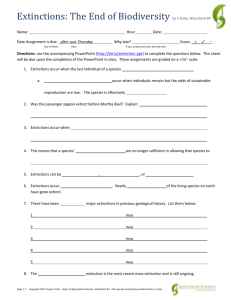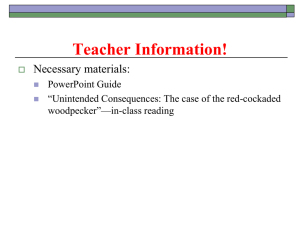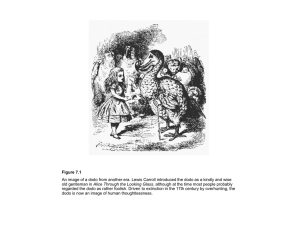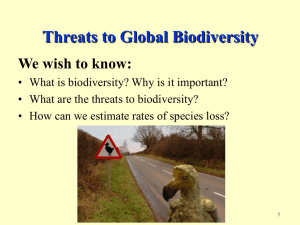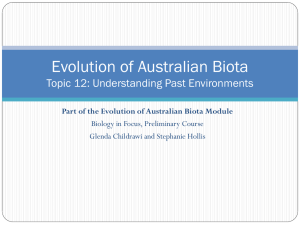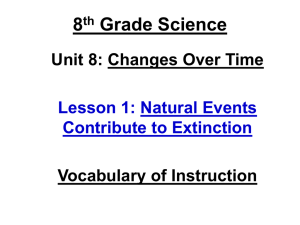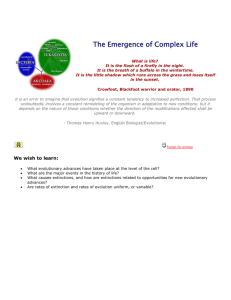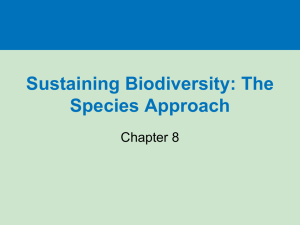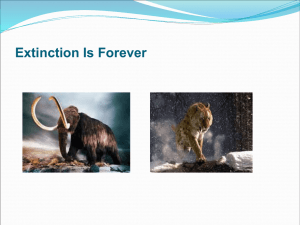Extinctions PPT
advertisement
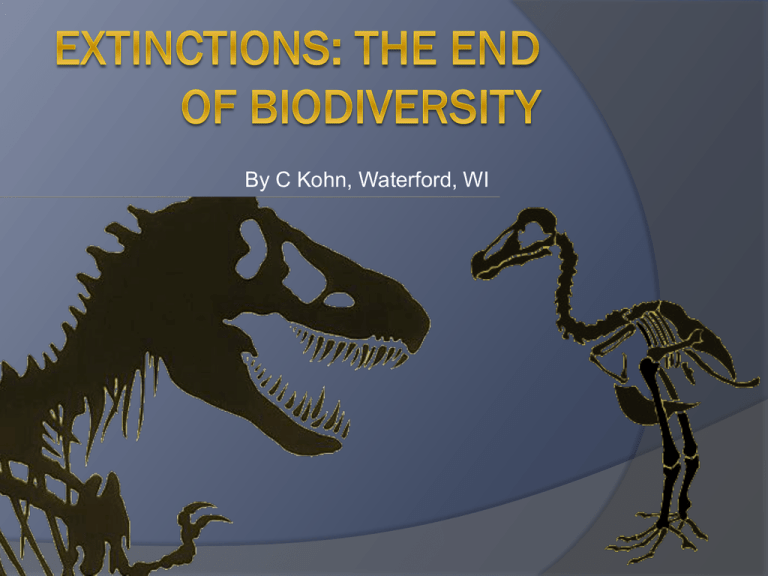
By C Kohn, Waterford, WI What is extinction? Extinctions occur when the last individual of a species dies out. Functional Extinctions occur when individuals remain but the odds of sustainable reproduction are low i.e. the species is effectively extinct even though individuals remain. The passenger pigeon The last passenger pigeon in Wisconsin was shot at Babcock, in September, 1899. This is reportedly the last passenger pigeon shot in the wild. The last Passenger Pigeon, named Martha, died alone at the Cincinnati Zoo at about 1:00 pm on September 1, 1914. Within a few decades, the once most-numerous bird on Earth would be forever gone. Even when Martha was still alive, the species was already functionally extinct – it would never return to a sustainable population. When do extinctions occur? Extinctions occur when the environment of a species changes faster than the species can adapt. In other words, a species’ adaptations are no longer sufficient in allowing that species to acquire and compete for resources. Extinctions can be local, widespread, or global. For example, the timber wolf was until recently extinct in Wisconsin but not in Minnesota Wild elk and woodland caribou are now extinct in Wisconsin but may be found on game farms. Extinctions are natural. Extinctions occur naturally. Nearly all of the species that have existed on earth have gone extinct. There have been 5 major mass extinctions in geological history. Recovery from these events took millions of years. Mass Extinction Diagram Source: http://www.uwec.edu/jolhm/EH4/Extinction/Extinction.ppt Mass Extinctions 1. 2. 3. 4. 5. 6. Cretaceous-Tertiary Extinction (65 mya). End Triassic Extinction (200). Permian Triassic Extinction (250). Late Devonian Extinction (364). Ordovician-Silurian Extinction (440). Holocene Extinction (0 mya) (#= millions of years ago) Source: http://www.uwec.edu/jolhm/EH4/Extinction/Exti nction.ppt The Holocene Extinction Today’s massive loss of species has been dubbed the “Holocene Extinction” (we are currently in the Holocene epoch) Epoch: a portion of a geological period Catastrophic extinctions, as was the case when an asteroid-strike wiped out the dinosaurs, actually took many thousands of years to occur. The current extinction rate appears significantly greater. In other words, human-activity is killing off species faster than an asteroid could 65 million years ago. Source: United States Committee on Scientific Issues in the Endangered Species Act, National Research Council. Science and the Endangered Species Act. National Academy Press, Washington D.C. 1995 Current Stats 90% of all large fish have disappeared in the last 50 years due to overfishing. Myers, Ransom. Worm, Boris. Biology Department, Dalhousie University, Halifax, Nova Scotia, Canada, Rapid Worldwide Depletion of Predatory Fish Communities. Nature. Volume 423. P. 280. May 2003 The Audubon Society reports that 30% of North American songbird species are in significant decline. One in eight plant species are in danger of extinction within the next 30 years (ICUN Red List) The current rate of extinction is 1500 times greater than the normal, sustainable extinction rate. “Half of bird and mammal species will be gone in 200 to 300 years” Bjørn Lomborg, The Skeptical Environmentalist: Measuring the Real State of the World, Cambridge U. Press, Cambridge, 2001. Levin, Phillip and Levin, Donald. The Real Biodiversity Crisis. January, 2002. American Scientist, Volume 90, Number 1, Page 6 One species is going extinct every 20 minutes. Levin, Phillip and Levin, Donald. The Real Biodiversity Crisis. January, 2002. American Scientist, Volume 90, Number 1, Page 6 Modern Causes of Extinctions Major current causes of extinctions include: Habitat Loss: fragmentation, degradation, and outright destruction of ecosystems that support native ecosystems (leading cause). Invasive Species: the introduction or overpopulation of species that over-consume natural resources and are uncontrolled by predators (second leading cause). Over-harvesting: the removal of species at rates that exceed reproduction Pollution: introduction of harmful agents that reduce the effectiveness of a species’ adaptations The 4 Horsemen of Extinction These main four causes of extinction can be thought of as the Four Horsemen of Extinction. Much like the biblical horsemen of the apocalypse, these four factors have decimated populations of living species across the planet. “Profound Loss of Biodiversity” “Information on the rate of species introduction and the nature of the impacts of introduced species on native species and ecosystems allows inferences about extinction rates. The evidence all points to a global tragedy with a profound loss of biodiversity.” Daniel Simberloff, professor of environmental studies and director of the Institute for Biological Invasions at the University of Tennessee For the birds… “Of about 6 to 10 million currently existing species, we have still only identified 1 million.” “For groups that we know well, knowledge of very recent species extinctions…allows us to be certain that extinction rates are comparable to those of the great past extinctions.” “For birds, of about 10,000 species worldwide at least 128 have disappeared in the last 500 years about 1,200 are currently seriously threatened with extinction (all but three from human activities)” ○ Daniel Simberloff Since Plymouth Rock Biologists estimate that since the Pilgrims landed at Plymouth Rock in 1620, more than 500 species, subspecies, and varieties of our US plants and animals have become extinct. The situation in Earth’s most biologically rich ecosystems is even worse. There is nothing natural about today’s rate of extinction. ▪ http://www.fws.gov/endangered/esalibrary/pdf/Why_Save_Endangered_Species_Brochure.pdf So why care? Why does this matter? TPS Biodiversity & Medicine More than a quarter of all prescriptions written annually in the United States contain chemicals discovered in plants and animals. A few hundred wild species have stocked our pharmacies with antibiotics, anti-cancer agents, pain killers, and blood thinners. We have only discovered 10-20% of living species so far! http://www.fws.gov/endangered/esalibrary/pdf/Why_Save_Endangered_Species_Brochure.pdf Biodiversity & Agriculture There are almost 80,000 species of edible plants Fewer than 20 produce 90 percent of the world’s food. 4 crops (wheat, corn, rice, soybeans) provide most of the world’s food. If underutilized species are conserved, they could help to feed growing populations. http://www.fws.gov/endangered/esalibrary/pdf/Why_Save_Endangered_Species_Brochure.pdf Biodiversity & Crops During the 1970s the U.S. corn crop was almost completely wiped out by a leaf fungus. The corn crop was saved by interbreeding it with a rare species of wild corn from Mexico. Genetic engineering may also offer some hope by facilitating transfer of genes between species. This increases the value of wild strains which can be used as sources for new traits to be introduced into crops. • http://www.emc.maricopa.edu/faculty/farabee/biobk/biobookc ycles.html Biodiversity & Ecosystem Services Ecosystem services include air and water purification, detoxification and decomposition of wastes, climate regulation, regeneration of soil fertility, and the production and maintenance of biological diversity. These are the key ingredients of our agricultural, pharmaceutical, and industrial enterprises. Such services are estimated to be worth trillions of dollars annually. We get these services for free…for now. http://www.fws.gov/endangered/esa- library/pdf/Why_Save_Endangered_Species_Brochure.pdf Biodiversity & Moral Obligations Would our descendants forgive us for exterminating a unique form of life? Eliminating entire species has been compared to ripping pages out of books that have not yet been read. • http://www.fws.gov/endangered/esalibrary/pdf/Why_Save_Endangered_Species_Brochure .pdf

